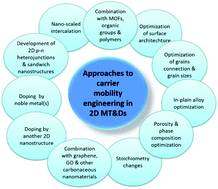Challenges and recent advancements of functionalization of two-dimensional nanostructured molybdenum trioxide and dichalcogenides
Abstract
Atomically thin two-dimensional (2D) semiconductors are the thinnest functional semiconducting materials available today. Among them, both molybdenum trioxide and chalcogenides (MT&Ds) represent key components within the family of different 2D semiconductors for various electronic, optoelectronic and electrochemical applications due to their unique electronic, optical, mechanical and electrochemical properties. However, despite great progress in research dedicated to the development and fabrication of 2D MT&Ds observed within the last decade, there are significant challenges that affected their charge transport behavior and fabrication on a large scale as well as there is high dependence of the carrier mobility on the thickness. In this article, we review the recent progress in the carrier mobility engineering of 2D MT&Ds and elaborate devised strategies dedicated to the optimization of MT&D properties. Specifically, the latest physical and chemical methods towards the surface functionalization and optimization of the major factors influencing the extrinsic transport at the electrode-2D semiconductor interface are discussed.

- This article is part of the themed collection: Recent Review Articles


 Please wait while we load your content...
Please wait while we load your content...